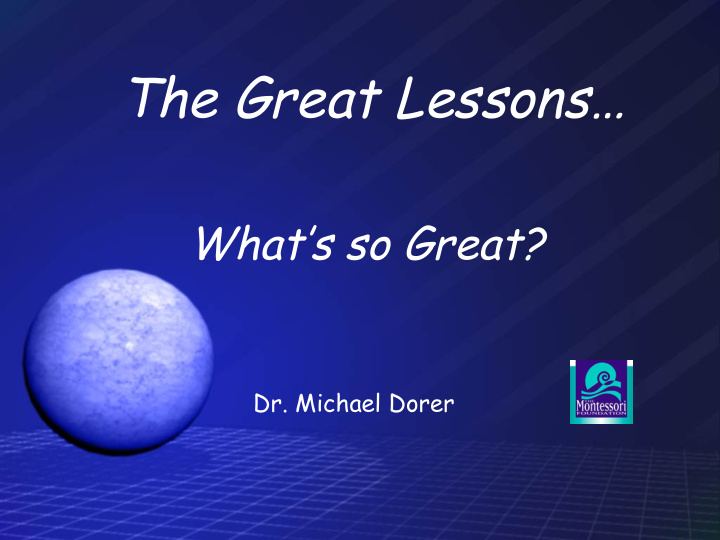



The Great Lessons… What’s so Great? Dr. Michael Dorer
The Elementary Themes A. The History of The Universe B. Life and Living Things C. Humanity – its History and Accomplishments D. Human Communication E. The World of Mathematics
Integrative Elements • Holistic Approach. • Inspiring the Imagination. • Origins, storytelling, and drama • Gratitude and appreciation The Great Lessons .
What’s so Great? • The Great Lessons are an umbrella for the entire scope of the Montessori curriculum. • They contain moral lessons, and relate to feelings, will, and character. • They establish origins. • They inspire and motivate.
What are the Great Lessons? • The First Great Lesson: The Story of the Universe. • The Second Great Lesson: Life Comes to Earth. • The Third Great Lesson: Human Beings Come to Earth. • The Fourth Great Lesson: The Story of Language. • The Fifth Great Lesson: The Story of Mathematics.
Rationale and Background • Why Great Lessons? • Where did the Great Lessons originate? • Are they all absolutely true? • How and when should they be given? • Who are they for? • What about follow up work?
The First Great Les son The Story of the Universe The Story of Creation
The Story of the Universe • The Experiments • Setting the Stage in Time • What about: “ The God with no Hands? ” • Note: Be sure to have Impressionistic Geography Charts 1-6.
The Story of the Universe • Particles were attracted to one another. • The “ Big Bang. ” • The gasses expand and coalesce. • The sun and planets are created. • The earth cools. • The rain falls. • The stage is set for life.
The Second Great Lesson Life Comes to Earth
Materials for Life • The Story - oral. • The Mural of Life. • Later: The Time Line of Life.
The Coming of Life to Earth • Life began in the water. • Life began as plant-like forms. • Life met many challenges.
New Life • Animal life emerged • Life Diversified and became Complex • Life pioneered the land and went through many changes. • The stage is set for a New Form of Life .
The Third Great Lesson Human Beings Come to Earth
Human Beings Come to Earth • Humanity represents something entirely new. • The Timeline of Humans • Humans bring three great gifts.
The First Gift of Humanity The Conscious Reasoning Mind • Imagination • Abstraction • A Higher Form of Love
The Second Gift of Humanity The will, which develops from the Horme ’ .
The Third Gift of Humanity The hand, which is freed by the upright stature.
The Apparent Sequence • Australopithecus afarensis - 3.5 million years ago. • Homo habilis - 2.5 million years ago • Homo erectus - 1.8 million years ago • Neanderthal - 500, 000 years ago • Homo sapiens - 400.000 years ago
Humanity Met Many Challenges Humans developed unique ways to meet their fundamental needs: • Tools. • Mastery of fire. • Use of caves for housing. • Cooperation. • Clothing. • Tanning Hides.
Late Stone Age • Domestication of dogs • Pottery • Housing • Agriculture • Animal husbandry • Fishing • Boats • Working with metals • Language
Spiritual Needs • Art • Religion • Jewelry and Adornment • Love
The Fourth Great Lesson The Story of Language
The Story of Language • Communication is a fundamental need. • This Great Lesson has three parts.
Speaking • The first part of this Great Lesson . • The First Human Word • What ’ s in a Name
Writing • The second part of this Great Lesson • The Alphabetic Principle • Beginning of alphabetic writing . • The Ox and The House • Writing diversified and became complex
Reading • The third part of this Great Lesson • The Piece of Paper that Sees and Speaks
A Possible Language Evolution
Indo-European Languages The most widely spoken family of languages in the world, containing these subfamilies: Albanian, Armenian, Baltic, Celtic, Germanic, Greek, Indo-Iranian, Italic (including the Romance languages), Slavic, and two extinct subfamilies, Anatolian and Tocharian. About 1.6 billion people speak Indo- European languages today.
A Timeline of English
The Fifth Great Lesson The Story of Mathematics
The Story of Mathematics • This Great Lesson has two parts. • It looks at the beginnings of number (Arithmetic) and Geometry
Parts of the Fifth Great Lesson • Dawn Child • How Counting Began • The evolution of numbers and numerals • The Story of Shapes and Sizes
Indian Numerals Brahmi numerals came into being around the middle of the third century BC. The Brahmi numerals may have come from the Indus valley culture of around 2000 BC.
Later Indian Numerals This form evolved around the 7th century AD and continued to develop from the 11th century onward. The name means the "writing of the gods" and it was the considered the most beautiful of all the forms which evolved.
Arabic Numerals Arabic numerals from an arithmetic book around the early 1300s in Morocco. It was in close contact with al-Andalus, or Andalusia, the Arab controlled region in the south of Spain.
Arabic Numerals Reach Europe Leonardo Fibonacci brought Arabic numerals to Europe, translating the Arabic text into Latin. It was used in European mathematics from the 12th century, and entered common use from the 15th century.
How Great are these Lessons? • They act as an umbrella for the entire scope of Montessori curriculum. • They contain moral lessons, and relate to feelings, will, and character. • They establish origins. • They strike the imagination. • They inspire and motivate.
Any Questions?
Recommend
More recommend